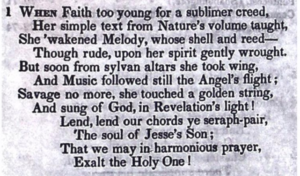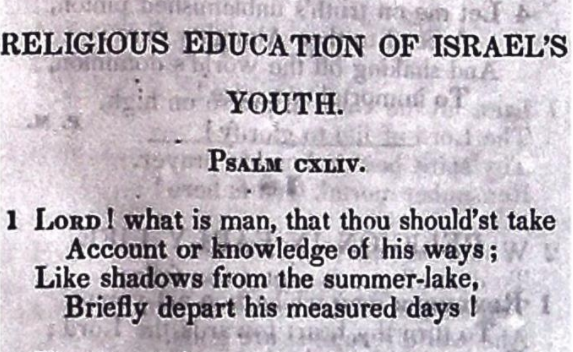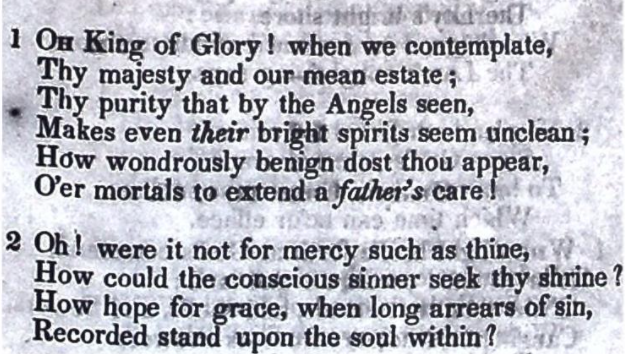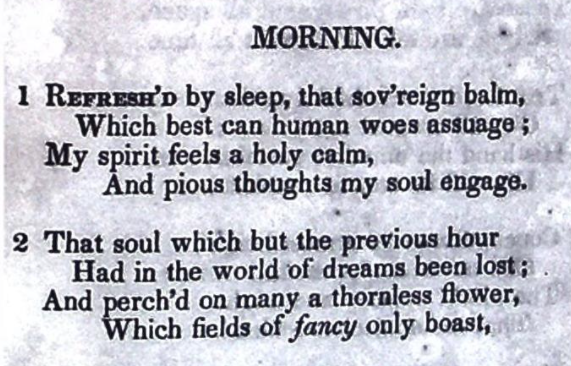Contributor(s): Shared on: 20 October 2021 under the Creative Commons Zero (CC 0) Universal license a Public Domain dedication Categories: Tags: | Contribute a translation | Source (English) |
|---|
|
When Faith, too young for a sublimer creed,
Her simple text from Nature’s volume taught,
She ‘wakened Melody, whose shell and reed–
Though rude, upon her spirit gently wrought.
But soon from sylvan altars she took wing,
And music followed still the Angel’s flight;
Savage no more, she touched a golden string,
And sung of God, in Revelation’s light!
Lend, lend our chords, ye seraph-pair,
The soul of Jesse’s Son,
That we may in harmonious prayer,
Exalt the Holy One! | |
Girt in His lightning robe, God gave the Law.
From trembling Sinai, to His eldest-born;
Tablets, that time from memory could not draw,
A talisman in Judah’s bosom worn.
His spirit before thousands past,
To one alone revealed;
And ‘mid the thunder’s awful blast,
Faith’s covenant was sealed. | |
“Him first, him last,” him ever let us sing,
Whose promise yet the Hebrew pilgrim cheers;
Who shall his wandering people once more bring,
Back to the glory of departed years.
Bright pillar of our desert path,
Through shame and scorn adored;
Thy mercy triumph’s o’er thy wrath,
Creator, King, and Lord! | |
Lost is the pomp, that in the land of palms,
Thy regal temple on Moriah graced;
No wreathing incense here Thy shrine embalms,
No cherub-plumes are round its altars placed.
Our censer is the “vital urn,”
Our ark’s upborne by zeal;
To these Almighty! wilt thou turn–
At Israel’s appeal. | |
Now, let joyous hallelujah’s ring,
The fallen casts her ashes far away;
Behold another Fane from ruin spring,
In brighter and more beautiful array.
Enter in brotherly accord
God’s holy dwelling-place;
Chastened in spirit and in word,
There supplicate His grace. | |
Hear, Supreme! our humble invocation;
Our country, kindred, and the stranger bless!
Bless, too, this sanctuary’s consecration,
Its hallowed purpose on our hearts impress,
Still, still let choral harmony,
Ascend before Thy throne;
While echoing seraphim reply
The Lord our God is One! |
This hymn for the 1842/5601 consecration of Congregation Beth Elohim by Penina Moïse, and was published that year as Hymn 1 in Hymns Written for the Service of the Hebrew Congregation Beth Elohim, South Carolina (Penina Moïse et al., Ḳ.Ḳ. Beth Elohim, 1842), pp. 5-6. –Aharon Varady Source(s)
 Ḳahal Ḳadosh Beth Elohim (Hebrew: קהל קדוש בית אלהים, also known as Ḳ.Ḳ. Beth Elohim, or more simply Congregation Beth Elohim), founded in 1749 in Charleston, South Carolina, is one of the oldest Jewish congregations in the United States. The founding members of the synagogue were Jews of Spanish and Portuguese descent (Sepharadim), who arrived into Charleston via London, England. Before 1830 Ḳahal Ḳadosh Beth Elohim was a place of worship for Spanish and Portuguese Jews using Portuguese rituals as done in Portugal before the Spanish and Portuguese inquisitions. A splinter group animated by the European Reform movement, the Reformed Society of Israelites, formed in 1824. While at first this group did not succeed in reforming Beth Elohim, by the mid 1830s Beth Elohim had reabsorbed its members and its ḥazzan, Gustavus Poznanski (1804–1879), joined the Reform camp in 1840. After the first synagogue building was destroyed by fire in 1838, it was rebuilt two years afterward (in a Greek Revival style designed by Cyrus L. Warner) with an organ to the chagrin of the traditionalists. Ḳahal Ḳadosh Beth Elohim is recognized as the oldest Reform Jewish congregation in the Americas.  Penina Moïse (1797-1880) was born to a large and wealthy family in Charleston, South Carolina, the progeny of her merchant father, Abraham Moïse (1736-1809), originally from Strasbourg in Alsace, France, and her mother Sarah from the Jewish community on the Caribbean island of Sint Eustatius in the Netherlands Antilles. Her brother, also named Abraham, was a leader in the Reformed Society of Israelites, and so we imagine she was closely associated with the reformist wing of the congregation it wished to and ultimately succeeded in reforming, Ḳ.Ḳ. Beth Elohim. Moïse wrote at least 187 prayers for Beth Elohim's hymn books published in 1842 and in 1856. Moïse was also a gifted teacher and, in 1845, became head of Beth Elohim’s religious school. Moïse was a prolific writer, earning praise for her 1833 collection of poems, Fancy’s Sketch Book, as well as her articles for various newspapers across the country. After the Civil War, she returned to Charleston and ran an academy with her sister and niece. Though her eyesight eventually deteriorated into blindness, she continued to work and write until the end of her life. (This short biographical sketch includes material adapted from her entry in the Jewish Women's Archive by Jay M. Eidelman.) Aharon Varady (M.A.J.Ed./JTSA Davidson) is a volunteer transcriber for the Open Siddur Project. If you find any mistakes in his transcriptions, please let him know. Shgiyot mi yavin; Ministarot naqeni שְׁגִיאוֹת מִי־יָבִין; מִנִּסְתָּרוֹת נַקֵּנִי "Who can know all one's flaws? From hidden errors, correct me" (Psalms 19:13). If you'd like to directly support his work, please consider donating via his Patreon account. (Varady also translates prayers and contributes his own original work besides serving as the primary shammes of the Open Siddur Project and its website, opensiddur.org.) Read a comment / Leave a comment (moderated) Works of related interest: |












Leave a Reply